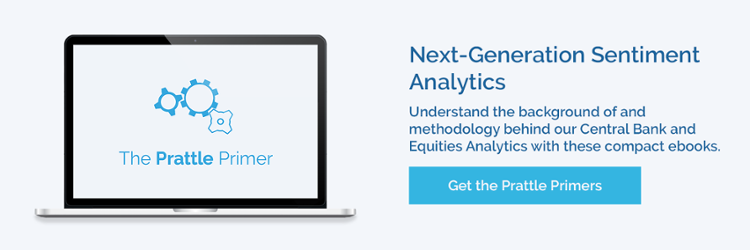This the 5th of a 6 part series on how cutting-edge text analysis technology is helping investors mitigate the detrimental effects cognitive biases can have on their decision-making.
The Age of Overload
Cognitive overload, the phenomenon sometimes referred to as “information overload” or “data asphyxiation,” hinges on the principle that humans can only process so much information at a time. Regardless of specific terminology, the general principle is the same: there’s more information available than ever before, the rate at which that information is being produced is accelerating, and information workers are drowning in data. As Paul Hemp at the Harvard Business Review writes
Current research suggests that the surging volume of available information—and its interruption of people’s work—can adversely affect not only personal well-being but also decision making, innovation, and productivity. In one study, for example, people took an average of nearly 25 minutes to return to a work task after an e-mail interruption. That’s bad news for both individuals and their organizations….A few years ago, a study commissioned by Hewlett-Packard reported that the IQ scores of knowledge workers distracted by e-mail and phone calls fell from their normal level by an average of 10 points.
Combine this with the consensus among managers that “most of the information they receive is useless,” and the severity of the problem posed by cognitive overload becomes clear.
It is vital for investment professionals to understand what information is important, come to the best conclusion based on what is important, and quickly act on that conclusion. So, a condition that buries key information, lowers your IQ, and increases the time it takes to act must be addressed.
From Noise to Signal
In essence, an individual suffering from cognitive overload cannot effectively focus. They are constantly overwhelmed by a flood of signals vying for their attention under the guise of critical information. So, the trick to overcoming cognitive overload is distilling the cascade of bad and good information into a steady, quality drip, allowing the decision maker to finally, actually focus.
Unfortunately for investors, there is a seemingly unending quantity and variety of information with the potential to impact asset pricing. And what’s worse is that some of the most relevant information is also among the most notoriously difficult to efficiently evaluate: language.
In large part, this is because reading is time-consuming and error prone: “If top readers read at speeds of above 1000 words per minute (wpm) with near 85% comprehension, they only represent 1% of readers. Average readers are the majority and only reach around 200 wpm with a typical comprehension of 60%.” While a very, very select few can blitz through paragraphs and pages, grabbing all the essentials along the way, the vast majority of us read slowly and are lucky to score above a D when it comes to comprehension. But even if every investor were a super reader, the quantity of relevant material is already too great to comprehensively review. And it’s only growing faster.
As we’ve highlighted throughout this series, cutting-edge text analysis technology can offer investors a solution. Text analysis programs have the ability to gather, sort, and score more information more quickly than any analyst or even an entire team of analysts. Prattle’s system, for instance, processes more than 7 million words a week in real time during peak earnings call season, a feat that would be impossible for any purely human operation. In an age where the total quantity of available information is already enormous—and doubles every 18 months—this technology is not a luxury…it’s a necessity.
In addition to offering financial professionals a bird’s eye view of market information, text analysis solutions like these highlight, through salient scores, what individual asset or broader market trends merit closer attention. For instance, if the sentiment of an earnings call suggests an exceedingly positive tone when the reported numbers miss estimates and present weak guidance, that company warrants further study. This simple filter can save analysts time and aid in identifying key trading opportunities.
In short, text analysis is an ideal solution for the information-saturated: an efficient way to leverage an ocean of data and conduct comprehensive research without indefinitely extending the decision-making time horizon.
The Prattle Team


